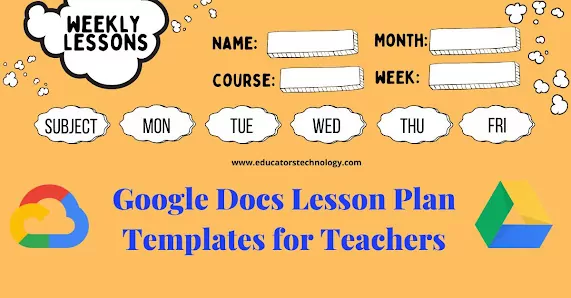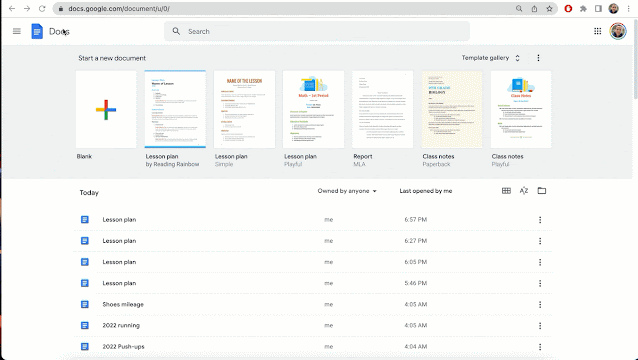Google Docs lesson plan templates are the topic of our blog post today!
The new Google Drive Template Galleries for Docs, Sheets, and Slides embeds some really interesting templates to use for a variety of educational purposes.There are templates for creating resumes; templates for writing letters, essays, book reports, and class notes. There are also work-related templates for creating things such as brochures, project proposals, newsletters and many more.
The thing with these pre-designed templates is that they are fully customizable and you can edit them the way you want. They free your mind from the design hassle and enable you to channel your focus to creating engaging and quality content.

The purpose of this post is to share with you three handy Google Docs lesson plan templates that you can use in your own instruction. These lesson plans are pretty basic in terms of design and graphics but you can always tweak them the way you want.
The important thing is to provide you with a ready-made outline to base your work on. As for customizing and modifying the elements of the template, the sky’s the limit. For more lesson plan templates options check out the free lesson plan templates post.
The Google Docs lesson templates I am sharing with you here in educatorstechnology.com are available for free from Google Docs templates gallery. You can easily access them by going to Docs galler, click on More button the top right corner, and scroll down to the bottom of the page to find them. Click on the one you want and it will open in your Google Docs editor where you can modify it to your liking.

These Google Docs lesson templates are titled: Lesson plan by Reading Rainbow, Lesson Plan (Playful), Lesson Plan (Simple). The Playful and Simple are actually the same lesson plan outline in different versions. Here is a quick overview of the main sections contained in each of these lesson plans:
Google Docs Lesson Plan Templates
I- Google Docs Lesson Plan by Reading Rainbow
The Reading Rainbow lesson plan contains a number of section each of which comes with tips on how to use them. The main section are:
A. Summary
The summary part is where you outline the main learning objectives and expectations behind the lesson. It also includes other information about grade level, subject, unit of study, topic of the lesson, etc.
B. Implementation
The implementation section contains the following sub-sections: Learning context (offers students the opportunity to connect learned insights from past lessons with the upcoming lesson), Procedure (covers the main techniques and strategies you use to realize your teaching goals such as direct instruction, guided practice, independent practice, formative assessment, etc).
C. Differentiated instruction
I especially like the inclusion of this section in this lesson plan. As teachers, we should always be conscious of the fact that students learn differently and that whichever instructional plan we devise it has to speak to the needs of all kinds of learners including visual learners, auditory learners, kinesthetic learners, learners with special needs, etc.
D. Materials and Resources
This section covers supplementary materials and resources (e.g., videos, books, PDFs, presentations, blog posts, etc) to use to enhance your instruction.
E. Assessment
The final part is the assessment part which can be in the form of formative assessment activities to gauge students comprehension.
II- Google Docs Lesson Plan Playful and Simple
The outline of this lesson plan is somehow similar to the previous one. It is consisted of the following (main) sections:
- Overview and purpose: Where you articulate the purposes behind your lesson together with a short overview of what the lesson is all about.
- Educational Standards: This is where you specify the educational standards your lesson targets and how it seeks to meet them.
- Objectives: Covers the learning objectives behind the lesson (I personally think this part is redundant and it can be easily included in the Overview and Purpose section above).
- Materials: Features the resources required to teach your lesson.
- Verification: This is the assessment part where you outline the activities and quizzes to use to check for student understanding
- Activity: This section features activities needed to reinforce the lesson.
Final thoughts
The introduction of Google Drive’s Template Galleries for Docs, Sheets, and Slides marks a significant step in streamlining and enhancing educational content creation. With a diverse array of templates for resumes, letters, essays, and even work-related documents like brochures and newsletters, these templates cater to a wide range of educational needs. The beauty of these pre-designed templates lies in their complete customizability, allowing educators to tailor them to their specific requirements while saving time on design aspects.
This post particularly highlights three versatile Google Docs lesson plan templates – Lesson Plan by Reading Rainbow, Lesson Plan (Playful), and Lesson Plan (Simple) – each offering a unique structure to assist educators in their planning process. From outlining learning objectives and materials needed to detailing differentiated instruction methods and assessment strategies, these templates provide a comprehensive framework for educators to build upon.
Accessible for free from the Google Docs templates gallery, they serve as an invaluable resource for teachers, simplifying lesson planning and ensuring a focus on delivering high-quality, engaging educational content.




